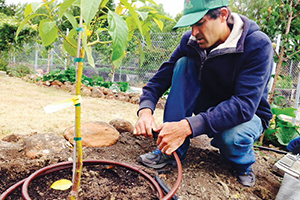By JULIE MINDA
With California more than four years into a severe and worsening drought, Catholic health care providers in that state are continuing to expand water conservation efforts; and, they are working with their local water agencies to determine how to comply with the state's conservation mandates.

California is more than four years into a severe drought — as can be seen in aerial views of Folsom Lake in Folsom, Calif., in 2011, at left, and in 2014. Californians are upping their efforts to conserve water — with some of the measures mandated, some voluntary. Ministry health systems and facilities are doing their part to preserve the scarce resource.
During an April news conference, Gov. Jerry Brown announced a mandate, through executive order, that California reduce water usage by 25 percent. The order also calls for increased enforcement of measures to reduce water waste, a streamlined government response to drought issues and state investment in new technologies to make California more water-efficient.
According to information from the State Water Resources Control Board of California, the emergency conservation regulations have to do, in part, with limiting the use of potable water for outdoor irrigation, and the timely repair of water leaks. According to George Kostyrko, director of the Water Resources Control Board Office of Public Affairs, 50 percent to 80 percent of water usage occurs outdoors, and leaks — some visible and some not — are common and costly. The California regulations deal with outdoor leaks, such as sprinkler leaks. In general, Kostyrko said, the utility is responsible for taking care of leaks located outside of a person's or business' property; and the person or business is responsible for leaks on their property.
Local water boards and agencies are responsible for implementing and monitoring the water usage reduction, and reporting back to the state.
According to Cheri Hummel, vice president of emergency management and facilities for the California Hospital Association, the water reduction mandate of 25 percent is a cumulative number for the state, and specific reduction goals vary widely from locality to locality, based in part on local conditions and on the impact of past conservation efforts in a given area.
According to water use reports Californians reduced water use by 27.3 percent in June, the first full month of the regulations.
Waste not

James Cook, the organic gardener at Dominican Hospital of Santa Cruz, Calif., works on the hospital’s drip irrigation system. Water drips slowly to the roots of plant, and the method reduces waste through water evaporation.
Hummel said plant operation representatives at hospitals across the state currently are coordinating with their local water boards to understand exactly what reduction targets apply to them and what approaches they should take to achieve those targets. Water boards later this year will begin monitoring water usage and providing reports to the state.
Catholic health system representatives in California told Catholic Health World that, like other health care providers in the state, they are working to comply with the mandate. Their facilities are coordinating with their local water agencies to learn exactly how the mandates will impact them.
Hummel said even prior to the beginning of the drought, California hospitals already had been incorporating water- and energy-efficient protocols and practices into their building operations. They've been doing this, in part, because of stipulations in state building codes, but it has long been the "new normal," she said, to continually improve upon mandated practices.
Sr. Mary Ellen Leciejewski, OP, director of ecology for San Francisco's Dignity Health, said before the drought began the system's hospitals made it a practice to watch for and correct water waste from evaporation, blow down and drift from cooling systems. Patient rooms have low-flow showers and toilets. Hospitals had been upgraded to water-efficient equipment or use conservation kits for sterile processing, a water-intensive process. They've converted to drip irrigation systems that use less water, but deliver more of it to the root system of landscape plants.
Such measures reduced water usage by a cumulative 7.4 percent across Dignity Health, between fiscal year 2008 and fiscal year 2013. Now, in response to the drought, Dignity Health hospitals are reducing their landscape watering to twice per week, and in some cases removing lawns. The campuses also are conducting assessments to determine what additional indoor and outdoor measures they could take to further reduce consumption. A streamlined data system Dignity Health had in place for its utility use helps facilities monitor and evaluate their water use.
To encourage employees to also conserve water, Dignity Health facilities are including water-saving tips in system hospitals' electronic newsletters.
Reusing wastewater
Providence Health & Services of Southern California also has many conservation measures in place and is looking to expand its efforts. Providence Saint Joseph Medical Center of Burbank recently partnered with the city of Burbank to expand its use of a water line providing reclaimed wastewater. The hospital had tapped into the line for outdoor watering uses in 2013, and recently began using the grey water to run its chilling systems. The increased use of wastewater required coordination with state health care regulators, and financial incentives from Burbank, including assistance accessing rebates from the local water district.
Also within Providence's Southern California area, Providence Holy Cross Medical Center in Mission Hills is among system facilities that are replacing some of their landscaping with drought-tolerant plants, and some of their grassy areas with artificial turf.
Providence Tarzana Medical Center in Tarzana is piloting a project to replace toilets with water-efficient models; and it is working with the Los Angeles Department of Water and Power to implement a cooling tower treatment project to reduce drain water, in large part by using new water treatment practices.
Providence Saint John's Health Center in Santa Monica is considering by early 2016 upgrading to a more efficient water treatment system for its cooling tower, installing flow restrictors in faucets, retrofitting toilets to conserve water and installing moisture sensors in landscaping.
Trinity Health's Saint Agnes Medical Center in Fresno, Calif., has installed a drainage and storage tank system to capture overflow from cooling towers for use in irrigating landscaping.
According to an article last year in Stanford University's Stanford Report, California's drought is linked to unusually low precipitation, unusually warm temperatures and stagnant air conditions. The report says a research team led by a Stanford University School of Earth Sciences climate scientist believes the situation is very likely linked to human-caused climate change.
Sr. Leciejewski said ministry efforts to conserve water continue, in part because "we realize how precious water is — that it's a gift" that must be properly stewarded, in line with Catholic principles. Plus, the efforts are important, she said because "there is no end in sight" for the drought.
Copyright © 2015 by the Catholic Health Association
of the United States
For reprint permission, contact Betty Crosby or call (314) 253-3477.